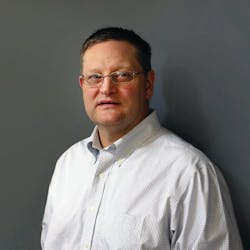An interview with Dr. Brian DuChateau, VP of Scientific Affairs, Binding Site
What’s your educational background?
I received my Bachelor of Science degree with a double major in Medical Microbiology and Immunology at the University of Wisconsin-Madison. From there, I continued my education at the University of Wisconsin, graduating with a PhD from the Department of Bacteriology with an emphasis in Medical Microbiology and Immunology. I completed a post-doctoral residency in Clinical Immunology at the Chicago Medical School and later received board certification from the American Board of Medical Laboratory Immunologists (ABMLI).
What is your career background?
I started my career on the clinical service side of immunology directing clinical diagnostic laboratories. I directed a large, multi-site clinical diagnostic reference laboratory representing over 300 employees in nine different labs conducting over 2.5 million tests per year. Subsequently, three partners and I established a laboratory with a mission to integrate clinical and anatomic pathology using innovative testing methodologies (like molecular diagnostics and flow cytometry) and informatics. In 2009, I made the transition from clinical service to the IVD industry. Currently, I’m the VP of Scientific Affairs at Binding Site, where I have the opportunity to lead market development initiatives while also providing scientific support.
What is the most rewarding aspect of your job?
I am an entrepreneur at heart, but I’m also a technically driven guy. So, I really like the technical aspects of my job along with the commercial responsibilities. It is very rewarding to know that what I do helps medical professionals help patients.
What projects are you currently working on?
I am very excited to be involved in one of the largest R&D initiatives ever embarked upon at Binding Site. As experts in protein diagnostics, we are leveraging our expertise to develop a quantitative immuno-precipitation technique that uses MALDI-TOF MS to detect protein targets.
This technology could be applied to a wide variety of different targets, but our first application will be for the detection and quantitation of para-proteins associated with monoclonal gammopathies. This technology has the potential to significantly improve the way we diagnose and monitor patients with monoclonal gammopathies. The system is intended to overcome many limitations associated with conventional serum protein electrophoresis and immunofixation. Our goal is to develop a system that will demonstrate increased sensitivity, unambiguous result interpretation, results that are not confounded by the presence of therapeutic mAbs, along with automation and improved workflow. Our plan is to launch a CE-IVD version of this system in Europe in 2021, followed by a launch in the United States upon FDA clearance in 2022.
What’s the biggest challenge the clinical lab is facing today? Any ideas on how to solve this challenge?
The clinical laboratory is constantly being asked to do more with less. Despite decreases in reimbursement and institutional budgets, labs continue to face expanding menus of complex testing methodologies and our aging population in the U.S. is driving increased testing volumes. This challenging situation is exacerbated by a continued shortage of skilled laboratory personnel.
Solutions to help with these challenges include the utilization of more automated instrumentation and advanced diagnostic technologies. New analyzers in areas such as mass spectrometry provide greater capacity and throughput while significantly reducing hands-on labor time. This could provide lab personnel more time to focus on result interpretation, quality requirements, and taking leadership roles in multi-disciplinary initiatives such as guideline-compliant testing for high-impact disease states.
What do you hope will be accomplished in the clinical laboratory in the next five to 10 years?
I hope for several things: That we will see the advent of new diagnostic methodologies utilized for Minimal Residual Disease (MRD) detection; that we will more comprehensively understand the clinical significance of genotypes identified using molecular techniques; that there will be an even greater emphasis on the development of companion diagnostics; and that Current Procedural Terminology (CPT) coding and reimbursement rates will keep better pace with the development of new innovative diagnostic methodologies.
What advice do you have to those looking to enter the clinical laboratory field—whether it be as a laboratorian or an executive such as yourself? Currently in the United States about 10,000 people turn 65 each day. From a clinical lab perspective, that creates opportunity on at least two different fronts: (1) An aging population increases diagnostic testing volumes; and (2) as individuals retire from an industry already stricken by labor shortages, more job opportunities are created. So, my advice would be that the time is right to start a career in the clinical laboratory field.
In your opinion, what is the most interesting thing going on in the clinical laboratory today?
I think cell-free DNA, circulating tumor cells (CTCs), and single-cell analysis all hold true promise. Laboratory technologies that could become routine and significantly improve upon the manner in which we diagnose and monitor disease in the clinical lab is always top of mind.
What do you like to do off the clock?
I have three sons who are involved in youth wrestling, which takes up a lot of my time. I also very much enjoy trout fishing, especially the rivers in northern Michigan. When I retire, I would like to become a full-time fisherman.

